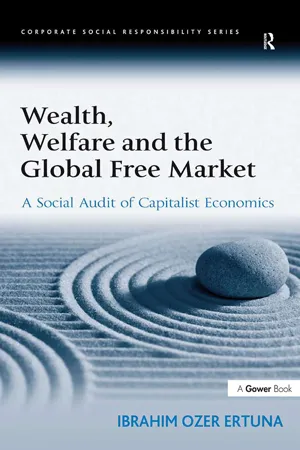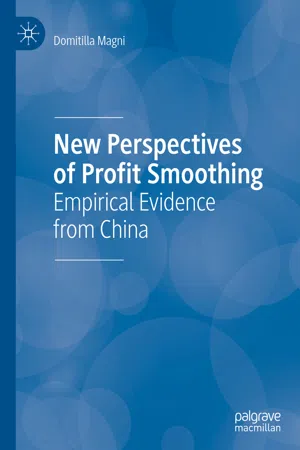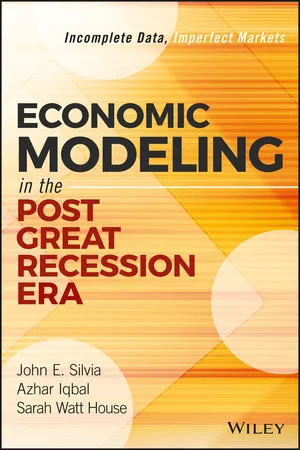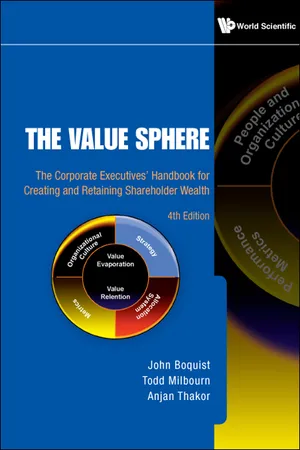Economics
Profit
Profit refers to the financial gain realized from a business or investment after all expenses have been deducted. It is a key measure of success for businesses and is essential for their sustainability and growth. In economics, profit serves as a reward for entrepreneurship and risk-taking, and it incentivizes efficient allocation of resources.
Written by Perlego with AI-assistance
Related key terms
Related key terms
1 of 4
Related key terms
1 of 3
7 Key excerpts on "Profit"
- eBook - ePub
Wealth, Welfare and the Global Free Market
A Social Audit of Capitalist Economics
- Ibrahim Ozer Ertuna(Author)
- 2016(Publication Date)
- Gower(Publisher)
Under the assumptions of the capitalist free market economy, with prices developed in the perfectly competitive markets, theoretically, all the markets are cleared and factors of production receive their fair shares from the output. If the Profits are considered as returns to entrepreneurial skills, entrepreneurs will get their proper share from the income generated. So the competitive markets provide full employment and fair returns to all factors. There may not be the problem of generating more or less income. But in real-life cases, there is a dilemma, since Profit maximization may not necessarily lead to income maximization. In fact, companies’ decisions for Profit maximization may well reduce countries’ national income. These issues will be discussed below. The Definition of Profit The concept of Profit has different meanings in economics and accounting. In daily usage, the accounting concept is used. In economics, Profit is the residual income left after payments are made for all the factors of production. As we have mentioned above, in free market economies, Profits are eliminated: the value added that is created by production is totally distributed to the production factors. Every one of the production factors receives its appropriate returns. Economic theory assumes that firms earn revenues by selling the products they produce. As the firm sells more products, prices decline, so the contribution of additional sales to revenues will decrease. This additional revenue is called “marginal revenue” in economics. The costs of the products sold consist of both the costs of input materials and the factor costs. That is, the costs considered are costs of materials, labor, capital, and all relevant costs pertaining to the production and sale of the products. Again, under the assumptions of economics, the costs of additional production and sale follows first a decreasing, then an increasing trend. The additional cost is called “marginal cost” in economics - eBook - ePub
New Perspectives of Profit Smoothing
Empirical Evidence from China
- Domitilla Magni(Author)
- 2019(Publication Date)
- Palgrave Macmillan(Publisher)
accounting rules. Many, from the classical economists, have tried to approach the issue of Profit and its assessment; others have governed just the accounted nature and added, in an already-busy contest, many theories and definitions on the subject. The evolution of knowledge of business, finance, and economics has allowed an increase in previous studies on Profit. Firm and its management have become, over the years, the main focus of managerial analysis, assuming relevance that is both increasingly global and interdisciplinary. The rules and economic directives require continuous management apparatus, overwhelmingly, on the ability to persist over time, in conditions of economic and financial equilibrium. Changing the appearance and nature of the firm changes accordingly the approach of business manager and the role of Profit management. Profit has always been analyzed as a residual item in the firm but it changes its shape, and is approached by most as a strategic financial variable.Profit must be closely related to the concept of enterprise, and, in that sense, the very determination of Profit justifies the existence of all the firm’s production equipment and is considered indispensable and underlying any business activity. At a firm level, Profit is considered as a goal to itself or, alternatively, in connection with other goals such as growth or efficiency.1Before analyzing all the literature and theories of economists who have debated the notion of Profit,2 it is necessary to clarify how and through which mechanisms the search for Profit can influence the business behaviors, and, finally, it is appropriate to dissolve some inherent nodes both the role of Profit as an economic category and its nature.From these initial considerations, it is understood that, in the first place, the subject of the Profit should be identified. The need to differentiate, in a theoretical way, the Profit from the worker’s wage, from the natural resource owner’s income, and from the interest generated by the liquidity loan, manifests itself at the same time as the historical process of capitalist division of labor.3 In this case, the historical recalls are fundamental: on the one hand, the progressive fragmentation of trades into specializations, the fragmentation of craftsmanship, and the expansion of the merchant system have prompted the making of entrepreneurs-merchants, concerned about buying the products to bring them to the markets and to sell raw material to every single producer, gaining a Profit. On the other hand, the separation of workers from work tools, the organization of work in the factory, and the continuous technological changes have overwhelmingly overlooked the overproduction of production, creating new problems with regard to its appropriation and its intended use for purpose consumption or accumulation. In parallel, a new social structure emerged, in which a class—that of entrepreneurs-producers—took the power to decide how, what, and how many to produce.4 - eBook - ePub
Entrepreneurial Finance
Fundamentals of Financial Planning and Management for Small Business
- M. J. Alhabeeb(Author)
- 2014(Publication Date)
- Wiley(Publisher)
CHAPTER 8Profit AND THE COST–VOLUME ANALYSIS8.1 Profit Concept Between Economics and Accounting
There is no doubt that “Profit” is the most common and widely used term in the business world. However, the commonality and popularity of the term does not necessarily make it a clear concept with an unequivocal connotation. When the classical economics specified the four major factors of production as land, labor, capital, and entrepreneurial management, it also specified the payments these factors get for their individual contribution in the production process. These payments are respectively: rent, wages, interest, and Profit. From here we can conclude that Profit is the monetary return to those who initiate and manage the entrepreneurial function of production. If the first three payments (rent, wages, and interests) are made out of the product's sale revenue, the residual, if any, would constitute the fourth payment to the entrepreneur or owner as Profit. It is in this sense we get the equality between Profit and the net revenue since what we call Profit is in fact the surplus over and above the costs of production. These costs may also include taxes, financing cost, and the like. Technically, Profit would equal the difference between the total cost of production (TC) and the total revenue brought by the sale of products (TR).It is worthwhile to note here that while the term total revenue is a clear and well-defined concept, the total cost is less clear. Total revenue is the dollar value of the product sold, which is obtained by multiplying the quantity of the units of products sold by the market price per unit. Total cost could include only the explicit cost or the outlay such as the expenditures on the factor of production mentioned earlier and other direct payments such as taxes and interests on loans. If the total cost includes only the explicit cost (EC), the calculated Profit would be considered as business or accountant's Profit (πa - eBook - ePub
Economics for Policy Makers
A Guide for Non-Economists
- Gustavo Rinaldi(Author)
- 2019(Publication Date)
- Routledge(Publisher)
The video presents some concepts presented in this unit. The fact that accounting Profit is positive does not mean that the business creates value. If opportunity costs are added, a Profit may become a loss. Many businesses may operate for long periods without generating economic Profit; they basically survive and remunerate intermediate consumption, capital and labour, but do not add any further value. This is the frequent case with many small businesses.A company can have economic losses while it is posting accounting Profits. An example: in 2002, McDonald’s posted accounting Profits of $893m but if investors put their money into an investment with similar or lower risk projects, they earned an additional $124m (Table 1.6 ).Glossary
accounting ProfitProfit calculated according to accounting criteria; it includes only explicit costs. It is the basis for paying taxes and dividends and for obtaining credit from banks.capitalA firm’s capital is the sum total of (1) financial assets including cash and funds held in deposit accounts at banks, (2) tangible equipment and machinery used in the firm’s production operations, (3) buildings used in the production or storage of the firm’s goods. The materials consumed in the course of the production process are not classified as capital.depreciationThe annual loss of value accruing to the capital of a firm or country due to wear, obsolescence and accidents.economic ProfitProfit calculated according to economic criteria: it is an instrument for deciding whether or not to pursue a project. It indicates that a project or a firm creates value, i.e. that the value of the output is greater than the value of all inputs used. If positive, it indicates that the value obtained with this use of resources in one project or firm is greater than the value achievable with the best alternative use of the same resources. - eBook - ePub
Economic Modeling in the Post Great Recession Era
Incomplete Data, Imperfect Markets
- John E. Silvia, Azhar Iqbal, Sarah Watt House(Authors)
- 2016(Publication Date)
- Wiley(Publisher)
Profits are the returns on investment and are a prime motivating factor in the economy. Past Profits and anticipated future Profits directly affect business actions such as capital expenditures and hiring workers. Profits have three interesting roles in economic activity. First, Profits act as a reward for entrepreneurship and innovation, as evidenced in the fortunes that accrued to innovators such as Thomas Edison, Henry Ford, Andrew Carnegie, John D. Rockefeller, Steve Jobs, Larry Page, Sergey Brin, Jeff Bezos, Bill Gates, and Paul Allen.Second, Profits act as an incentive to invest and speculate on the possibility of above-market returns. Higher anticipated future returns prompted individuals to invest in the auto and radio industries in the first half of the twentieth century and in consumer services such as department stores and fast food after WWII. In recent years, consumers have invested in technology, specifically technology focused on processing and communicating information—such as the exercise of apps on mobile phones. Profits also served as an incentive for the establishment of the Virginia colony in American history.4Finally, Profits often serve as a key contributor to the rising values in savings and investment accounts that are employed by households to meet many financial goals, including home purchases, college education, and retirement funding. Although overlooked or simply not understood by many, Profits are the key to the growing nest eggs that finance much of economic activity. Innovations such as mutual funds, individual retirement accounts (IRAs), pensions, and, more recently, exchange-traded funds (ETFs) gain value over time as Profits grow. As illustrated in Figure 6.4 , Profits contribute to personal income through the receipts on assets, proprietors’ income (self-employed Profits), and as a supplement to wages and salaries (via contributions to employee pensions and government social insurance).Figure 6.4Personal Income SourcesSource: - eBook - ePub
- John Smithin(Author)
- 2008(Publication Date)
- Routledge(Publisher)
6 A theory of ProfitIntroduction
There are two aspects to a theory of Profit. The first is the technical monetary question of how it is possible for Profits denominated in the unit of account to actually be “realized”. (That is, how can it be that M' can be numerically greater than M ?) This requires a theory of endogenous money and credit creation, as discussed in earlier chapters of this book. In addition to this, however, there is also the issue of “real” Profits – how does the system generate a surplus in the form of goods and services greater than the amounts of goods and services that went into production, or were used up in production? This is ultimately a matter of real income distribution, in modern terms a question of the distribution of real GDP. The sort of question that is asked, for example, is – what determines the Profit share in GDP?This purpose of this chapter is to deal with the second rather than the first of these two aspects of the theory of Profit, though it should continue to be borne in mind that in a capitalist economic system the real surplus that is being discussed could not actually have come into existence without the mechanism of credit creation that first generates Profit in monetary form. As this is a point that is often lost or simply absent in most existing academic discussion of these questions, it is worth re-emphasizing at the outset.As is perhaps fairly well known, the orthodox neoclassical theory of eco-nomics is not a great deal of help is discussing Profit, and, in turn, this is a major handicap to that body of thought in the study of a capitalist economic system. In fact, in the supposedly “best developed model of the economy” (Hahn 1983, 1) in the orthodox tradition, that is the neo-Walrasian model of competitive general equilibrium, there is no Profit at all. Total income is distributed between wage and a sort of rental return to the owners of different types of purely physical capital, but there is nothing in the way of a surplus over and above the costs of production. Nothing, that is to say, that would be recognizable as Profit in the accounting sense. Out of equilibrium, it may be allowed that “short-run” Profits may accrue to a firm if it gets into a temporary position with some sort of monopolistic advantage. In fact, within this intellectual framework, these fleeting situations have to bear the whole burden of providing an incentive mechanism for the firm actually to do anything at all. In the “long run”, however, all these short-run Profits are supposedly “competed away”, leaving nothing but the costs of production. In the mathematical expositions of neoclassical theory, a “zero Profit condition” is imposed as a matter of course. - eBook - ePub
The Value Sphere
The Corporate Executives' Handbook for Creating and Retaining Shareholder Wealth
- John Boquist, Todd Milbourn, Anjan Thakor(Authors)
- 2009(Publication Date)
- WSPC(Publisher)
5. Economic Profit and Value Driver AnalysisThe purpose of adopting a metric such as economic Profit is not just to use it for high-level corporate strategy. We would also like to be able to use it to drive our day-to-day decisions. This is where economic Profit's role in value-driver analysis comes in.Figure 10.8 shows how to think about value driver analysis conceptually using economic Profit. The question every manager must ask is: What can I do to increase economic Profit? It turns out that, at a very high level, the ways to increase economic Profit correspond to the four quadrants in the prosperity diamond.Figure 10.9 shows how one can then drill down into the micro drivers of value to show how smaller pieces of the value-creation chain from the Profit and loss statement and the balance sheet all add up to economic Profit.6. Economic Profit is not a Financial Tool: Using Economic Profit to Create an Ownership MindsetIn our opinion, economic Profit is first and foremost a behavioral tool. It is all about minimizing the agency costs that are the source of friction and Value Evaporation in corporations (see Chapters 4 and 5 ).78Fig. 10.8. The prosperity diamond suggests that there are only four high-level ways to increase economic Profit.When an employee maximizes economic Profit, he takes into account all the things that owners do. Indeed, he is acting as a de facto owner of the asset he is managing. This means that tying performance assessment and compensation to economic Profit should create an ownership mindset. This enhances shareholder value.In fact, economic Profit is a decentralization mechanism. In a large organization, it is usually difficult for individual employees to see how they can have an impact on the corporate bottom line. And without a clear link between their actions and shareholder value, they find it hard to get motivated by speeches of senior executives telling them they should attend to shareholder value.
Index pages curate the most relevant extracts from our library of academic textbooks. They’ve been created using an in-house natural language model (NLM), each adding context and meaning to key research topics.
Explore more topic indexes
Explore more topic indexes
1 of 6
Explore more topic indexes
1 of 4






